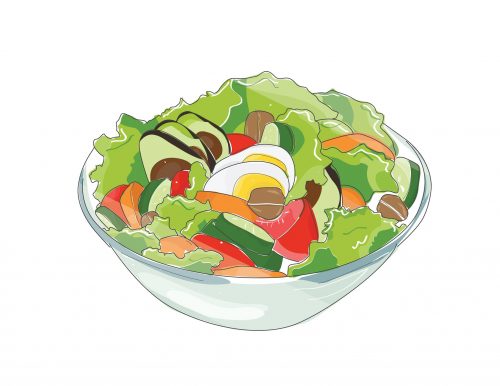
Salad: the staple of a density diet.
I’m going to go out a limb here.
I’m going to talk about food intake in terms of which most of us here are familiar: training variables.
When it comes to working out, we know we need to “wave the load” [intensity]; we can and should lower volume from time to time, and–I hope you gathered this from last week’s blog post –we must focus on density when using weights to get lean and drop body fat. Of course, all of these things allow us to train with greater frequency. And frequency is a good thing, when it comes to moving.
So what if we think about eating in the same we think about training?
What if we describe the way we eat in the context of these same training variables?
Frequency–how often you eat
Intensity/Load–how much you eat at one time
Volume–how much total eat total
Density–how much total you eat over time
Pat pretty much owns the circuit on the topic of eating frequency. I simply cannot link to all of those posts right here, but you can easily find a plethora of his writing detailing the many options available in the realms of fasting, intermittent fasting, and modified fasting. This one is a pretty fun one to play around with–whether for fat loss or general health.
Intensity/Load gets interesting. You can think of this as nutrient-intensity or straight-up caloric intensity. It’s sort of the “percentage of daily max” in terms of nutrition.
Volume, in diet as well as in training, can be described in number of ways–in terms of actual amount of food eaten, the “fillingness” of the food eaten, or actual caloric value of the food eaten. Examples: Veggies are filling but low in calories. They feel voluminous in your belly and help with satiation.
Density, in diet as well as in training, is a crossroads between volume and time. In training, it’s squeezing a boatload of work into a relatively short sliver of time; in eating, it’s squeezing a boatload of satisfaction and nutritional value into a limited amount of calories. Work with high-intensity flavors for extra pizzazz.
How can we apply this to our eating in order to make healthful decisions that will support our quest for bodies that look great naked?
We’ve got to work on our density.
Do you want to know why there’s not one universal diet that works for everyone? Because, just as there’s no “perfect training plan,” there is no “perfect diet.” There’s only ever the “perfect training plan for you” and “the perfect diet for you.”
It’s individualized. And what works for someone else may very well be unreasonable for you.
Also, just as a high-everything training plan would be a disaster, so is a high-everything eating plan.
There’s got to be the natural give-and-take, ebb-and-flow, yin-and-yang to balance all of the variables!
Do you like to eat often? Great, you’ve obviously got to limit volume and intensity per meal if you’re going keep feeling good with high-frequency, so don’t eat a whole bunch of calories each time you graze.
Do you like to feel really full? Great, go high-volume with low-intensity foods/beverages; i.e., eat lots of veggies and drink lots of water!
Do you really like to eat cheese? Of course you do! It’s high-intensity, though, so go low-volume and low-frequency.
Do you love avocadoes? Guac is to the diet what deadlifts are to training. Everybody loves it, but it can’t be binged upon. Avocadoes are hugely nutrient-dense and calorically-dense, and if you’re satiated by fat, then this is obviously a healthy option. If you’re a volume person, beware! Similarly, you cannot max all of your lifts during the same session, so pair those heavy-guac days with lots of low-intensity veggies. (Eat your guac on celery and bell peppers instead of on corn chips.)
Do you want to go big on ice cream? Just don’t. That’s like maxing on bicep curls.
3 Points of Application
- Really good training program design starts with determining your maxes. Do this for your diet by determining your ideal caloric intake and even macronutrient breakdown.
- Reflect on your current, natural style of eating. What are your preferences? Do you like to eat often? Eat big? Eat hard? Use your preferences in order to fine-tune the balance of the variables.
Or, if what you’re doing isn’t working at all, why not swing it the opposite way for a challenge? Why not see what happens when Snacky McSnackerson makes adjustments to instead eat two 800-calorie meals daily?!
- Be aware of how others’ eating variables influence yours and adjust accordingly. Just because you’re working out with someone, doesn’t mean you should lift what they lift, how they lift, as heavy as they lift, right? So, if you’ve been eating high-intensity all day and then you go out with friends who want to order nachos and beer, consider some low-intensity munching on a green salad for the duration.
*Bonus: Obviously, avoid calorically-intense, nutritionally-void foods. The closer the food is to its natural state (the less a food is processed), the more likely that it will satisfy you with all variables balanced.
And now, here’s your 5-Minute Sweaty. My best advice is to go VERY LOW volume in diet leading up to this one.
5-Minute Sweaty
Every minute on the minute for 5 minutes:
20 plyo lunges + 10 squat jumps + forearm plank hold (until the end of the minute)
P.S. Come get dense with us! The only thing better than a dense kettlebell workout, is a dense kettlebell workout with Pat, Aleks Salkin, Som, and me– ending with an intense hangout over a voluminous beer!
Seriously, though. It’s called Bells & Beer, and it’s awesome. (In fact, it’s how I met these guys all those fateful years ago, and look at me now! All the denser because of it!) Check it out and register HERE!